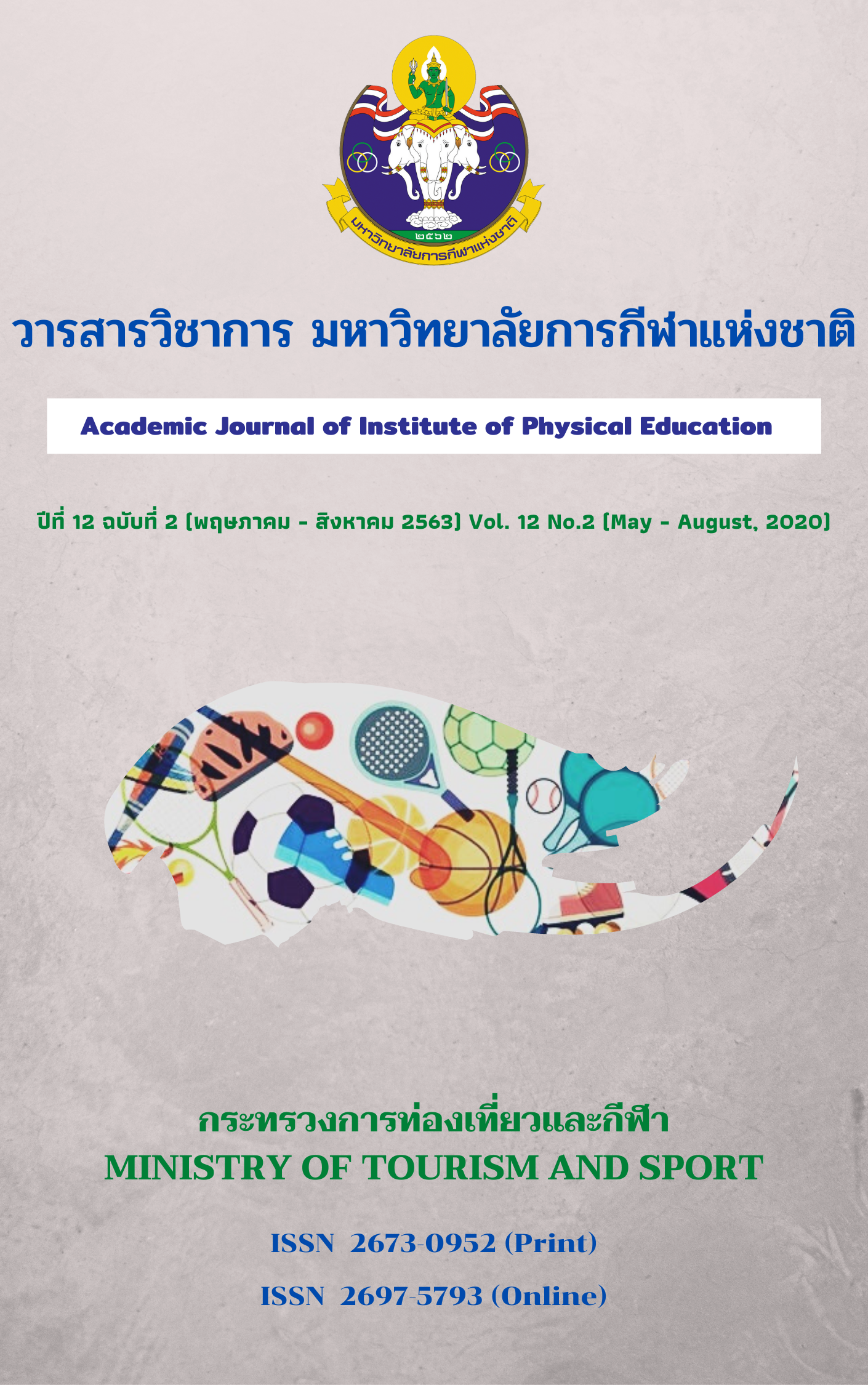THE EFFECTS OF A DRY-LAND TRAINING PROGRAM ON MUSCLE STRENGTH, FREESTYLE 100M, AND IGF-I CONCENTRATION IN YOUTH SWIMMERS
Main Article Content
Abstract
This study aimed to study the effects of a dry-land training program on muscle strength, freestyle 100m, and IGF-I concentration in young swimmers. The participants consisted of 11 male students of the Assumption College Sriracha swimming club, aged 9-15 years old, with 1-5 year swimming experience, divided into a control group and an experimental group with Match Pair and random assignment. The experimental group conducted with a dry-land training program for 12 weeks, 2 days a week (Tuesday and Thursday) while participants in the control group practiced with the regular training of Assumption College Sriracha swimming club. Muscle strength and freestyle 100 m were measured after dry-land training weeks 4, 8 and 12 and IGF-I concentration was tested after dry-land training week 12. The data were analyzed using the Mann-Whitney U test, Friedman test and Wilcoxon Signed Ranks Test.
The results were found that muscle strength and freestyle 100m of the experimental group after training week 12 were statistically increased at the significance level of .05 while no significance difference was found in IGF-I concentration after training week 12 and before training. No significant differences of muscle strength, freestyle 100m, and IGF-I concentration were found between the control group and the experimental group after training week 4, 8 and 12 at the level of .05. However, the change of muscle strength, freestyle 100 m, and IGF-I concentration in young swimmers were not clear. Thus, future study is needed.
Article Details
The published article is a copyright of the Academic Journal of Thailand National Sports University. The passage appeared in each article in this academic journal is a perspective of each author which is not related to the journal. Each author is required to be responsible for all components of his/her own article. If there are any mistakes, each author must be responsible for those mistakes on his/her own.
References
Aspenes, S., Kjendlie, P.L., Hoff, J., & Helgerud, J. (2009). Combined strength and endurance training in competitive swimmers. Journal of Sports Science and Medicine, 8, 357-365.
Balyi, I., Cardinal, C., Higgs, C., Norris, S., & Way, R. (2005). Canadian sport for life: Long term athlete development. Vancouver, BC: Canadian Sport Centres.
Balyi, I., Way, R., & Higgs, C. (2013). Long term athlete development. Champaign, IL: Human Kinetics.
Bamman, M. M., Shipp, J. R., Jiang, J., Gower, B. A., Hunter, G. R., Goodman, A., Charles, L., McLafferty Jr., & Urban, R. J. (2001). Mechanical load increases muscle IGF-I and androgen receptor mRNA concentrations in humans. American Journal of Physiology-Endocrinology and Metabolism, 280(3), E383-E390.
Bureau of Sports Science. (2006). The manual of sports science for improving young athlete performance. Bureau of Sports Science, Office of Sports and Recreation Development.
Girold, S., Calmels, P., Maurin, D., Milhau, N., & Chatard, J. C. (2006). Assisted and resisted sprint training in swimming. Journal of Strength and Conditioning Research, 20, 547-554.
Garrido, N., Marinho, D. A., Barbosa, T. M., Costa, A. M., Silva, A. J., Pérez-Turpin, J. A., & Marques, M. C. (2010). Relationships between dry land strength, power variables and short sprint performance in young competitive swimmers. Journal of Human Sport and Exercise, 5(11), 240-249.
Grant, M. C., & Kavaliauskas, M. (2017). Land based resistance training and youth swimming performance. International Journal of Sports and Exercise Medicine, 3(4), 1-11.
Han, D. S., Huang, C. H., Chen, S. Y., & Yang, W. S. (2017). Serum reference value of two potential doping candidates-myostatin and insulin-like growth factor-I in the healthy young male. Journal of the International Society of Sports Nutrition, 14(2), 2-7.
Krabak, B. J., Hancock, K. J., & Drake, S. (2013). Comparison of dry-land training programs between age groups of swimmers. PM&R, 5(4), 303-309.
Kraemer, W., & Ratamess, N. (2005). Hormonal responses and adaptations to resistance exercise and training. Sports Med, 35(4), 339-361.
Lanfranco, F., & Strasburger, C. J. (2016). Sports Endocrinology. Karger Medical and Scientific Publishers.
Malina, R. M., & Bouchard, C. (1991). Growth, maturation, and physical activity. Champaign, IL: Human Kinetics.
Morais, J. E., Silva, A. J., Marinho, D. A., Marques, M. C., & Barbosa, T. M. (2016). Effect of a specific concurrent water and dry-land training over a season in young swimmers’ performance. International Journal of Performance Analysis in Sport, 16(3), 760-775.
Pattharapong Keelapang. (1994). Insulin like growth factor I (IGF-I) in clinical. Chula Med J, 38(12), 787-804.
Riewald, S. (2015). Periodization and Planning. In Scott Riewald & Scott Rodeo (Eds.). Science of swimming faster. Champaign, IL: Human Kinetics.
Ruiz, R. J., Ortega, F. B., Gutierrez, A., Meusel, D., Sjöström, M.m & Castillo, M. J. (2006). Health-related fitness assessment in childhood and adolescence: A European approach based on the AVENA, EYHS and HELENA studies. Journal of Public Health, 14(5), 269–277.
Sauberlich, H. E. (1999). Laboratory tests for the assessment of nutritional status (Vol. 21). CRC press.
Sighamoney, R., Kachare, J. B., Yeole, U. L., & Tendulkar, S. (2018). Effectiveness of dry land strength training in competitive swimmers. Internaltional Journal of Academic Research and Development, 3(1), 415-419.
Tanaka, H., Costill, D. L., Thomas, R., Fink, W. J., & Widrick, J. J. (1993). Dry-land resistance training for competitive swimming. Medicine and Science in Sports and Exercise, 25, 952-959.
Thailand Swimming Association. (2018). Statistic swimming records online Resources. Retrieved January 9, 2019, from http://swimming.or.th/.
Thomas, P. R. (2013). Sample size determination and power. New Jersey: Hoboken.


